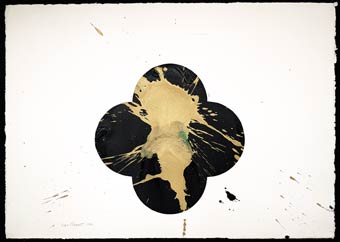 |
Recent Exhibitions
Introduction | Iconic Shapes | The Inks | Drawings Revisited | Collaborations
Max Gimblett: The language of drawing (17 May – 28 July 2002)
Iconic Shapes
 Max Gimblett Swan no.2 1986 Collection: Queensland Art Gallery. Reproduced with permission |
`I never knew where they came from or how they arrived'
Max Gimblett uses elemental symbols - the square, the circle, and the triangle - instinctually, as structures of contemplation. Over the years, an abstract symbolism has evolved for his paintings and works on paper, which has been inspired by religious thought and practice and by the teachings of Carl Jung. The ‘quatrefoil' shape arrived in 1983 and, as with his other symbols, has multiple meanings. These include the rosy crucifixion, the Buddha lotus and the Blakean diagram. Often these shapes are highly worked, in layers, from pencil through to spilled passages of paint and reflective metallic pigments. The paper is an important support, as it not only holds the drama of these images but also imparts additional aesthetic qualities to the work.
|
|
